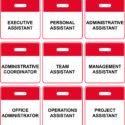
Become known as a consummate problem-solver and system-builder who can impact the business, says Mackenzie Lee
The CEO Pandemic
We’re in a CEO pandemic. Last year, 1,900 CEOs left their jobs; only 19 of them died in office, according to The Wall Street Journal. CEOs are quitting at such a high rate because the job is so unforgivable. A Deloitte report found that 82% of CEOs have experienced burnout and 96% feel their mental health has declined. Researchers named the usual suspects: long hours, stress, lack of sleep, lack of exercise, and poor eating habits.
Unfortunately, the same rates of burnout are on the rise with Executive Assistants to CEOs. These administrative professionals match the frenetic pace of their executives, only to quit in frustration or be asked to leave with their departing CEO.
What happens if your CEO and their Executive Assistant fail? Revenue falls, productivity slumps, and employee engagement sinks. Your company suffers by losing momentum, reputation, customer goodwill, and organizational trust – huge costs, estimated in the trillions (research by Cedar).
The Solution
So what can you do about this CEO emergency? Build a world-class Office of the CEO. This endeavor requires time, money, and patience, but the payoff is rich. You’ll dramatically reduce the workload for your CEO and for you as their Executive Assistant. You’ll avoid C-suite infighting and executive distractions. You’ll avoid disengaged employees. You’ll reduce risk and cost to the business.
As a result, you’ll boost CEO time and energy. You’ll turn your C-suite team into fast and fearless leaders. You’ll turbocharge topline growth. You’ll lead your industry by innovating at the cutting edge.
Finally, as an Executive Assistant, you’ll unlock more responsibility, better pay, and a strategic partnership with your CEO. So, Executive Assistants, here’s my call to arms: It’s time to put on your hard hats and get to building a world-class Office of the CEO.
What Is the Office of the CEO?
Let’s start with a definition drawn from our research with more than 1,000 Office of the CEO professionals. The Office of the CEO is the team that works together to maximize the impact of the CEO by leveraging a strong leadership operating system. In other words, the CEO Office is a high-performing team that follows optimized protocol for every CEO activity, enabled by the right tools. Remember, when the CEO can more effectively run leadership meetings, close new clients, engage customers, inspire employees, manage the board, and partner with investors, everybody wins.
Office of the CEO team
Who is on the Office of the CEO team? Our research identifies the most common Office of the CEO titles as follows: CEO, Chief of Staff, Executive Assistant, Communications Director, Business Manager, Strategy Director, and Deputy Chief of Staff. This Office of the CEO team brings diverse skillsets to the table, ranging from communications and sales to strategy, operations, product, board management, investor management, change management, and more. Relevant prior work experience for successful Office of the CEO team members includes management consulting, finance, operations, program management, and VP-level leadership.
Leadership operating system
The best Offices of the CEO leverage a leadership operating system – a set of defined processes and procedures for the executive team, enabled by playbooks, dashboards, and technology. In other words, there is a seamless integration of People, Processes, and Tools, which makes the Office of the CEO hum along smoothly. This system is architected in such a way as to deliver repeatable and predictable outcomes for leadership, including efficient meetings, better decisions, and smarter investments, all of which are the building blocks to running a successful business.
Why Build the Office of the CEO?
Implementing a proper Office of the CEO is no mean feat to pull off. But there are significant benefits to many folks, including your CEO, their Executive Assistant, C-suite, employees, prospects, customers, board members, and investors.
Within the company, your CEO better guards their time, protects their energy, and delegates more work. Your C-suite team makes quicker decisions and works on higher-priority projects. Your fellow rank-and-file colleagues feel a stronger connection to your CEO and execute against a well-defined strategy.
External stakeholders also stand to gain from the Office of the CEO. Prospective new employees feel inspired by special outreach from your CEO. Your most strategic customers meet with your CEO to plan for long-term partnerships. Your board and investors retain a strong relationship with your CEO and jointly drive your company’s growth plans.
Unique benefits to Executive Assistants to the CEO
While there are strong incentives for all stakeholders to build the Office of the CEO, there are significant benefits for administrative professionals that are worth mentioning. If you build a strong Office of the CEO as an Executive Assistant to the CEO, you reduce your personal workload, avoid burnout, and minimize toxic leadership. In other words, you reduce the risk of poor CEO performance and CEO termination, protecting your role as the trusted partner to your CEO.
What’s more, if you lead the way to continually improve your Office of the CEO, you gain more trust from your C-suite. This can lead to more responsibility should you desire it, which results in better compensation, title, and respect from your peers. In particular, Executive Assistants looking to step into the Chief of Staff role can successfully make the business case for promotion by pointing to their long-term efforts to build the Office of the CEO and the exact benefits they have delivered to C-suite executives.
How Do You Build a World-Class Office of the CEO?
Great, so you’re excited about investing time and energy in the Office of the CEO. But building the Office of the CEO is a long-term project that can be easily derailed by your day-to-day workload as a CEO, Chief of Staff, or Executive Assistant. That’s why you must carve out time, secure resources, and map out a repeatable process to continually uplevel your Office of the CEO. Read on to learn more about the three-phase approach to creating a high-functioning CEO Office: Assess, Design, and Deploy.
Phase 1: Assess
To start upleveling your Office of the CEO, you need to complete an assessment of where you are today. You must review your current state, identify user needs, and define a problem set that describes your present-day Office of the CEO. Make sure you document everything as you go along. Your paper trail will better guarantee executive buy-in, develop your strategy and writing skills, and form the business case for your next promotion.
To ensure you complete a comprehensive assessment, you may leverage our Office of the CEO Maturity Model. At Cedar, we have functionally deconstructed the Office of the CEO into 60 success factors grouped into 5 measurement areas: Strategy, Planning, Team, Enablement,and Execution. Sample factors include Office of the CEO mission, success metrics, ROI, hiring, CEO protocol, and more. More information about the model and the exact variables that underpin your Office of the CEO can be found here.
To start your assessment, examine your current state by running a quantitative survey with your Office of the CEO teammates. For each variable of the maturity model, have them rank your Office of the CEO from Level 0 – Undefined to Level 5 – Optimized. Collect the data and assemble a heatmap of the results by marking each variable Red, Amber,or Green depending on the respective maturity level.
Essentially, you create a report card for your Office of the CEO, where green means On Track, Amber means At Risk, Needs Development, and red means At Risk, Needs Attention Now. For example, red items could be Meeting Protocol because meetings drain time, Workload Analysis since your team has been working 12-hour days, and Succession Planning since your Chief of Staff is leaving the company in a few weeks.
Next, follow up your quantitative survey with qualitative interviews to dig deeper into Office of the CEO problems. Ask the following three main questions:
- What are your biggest pain points?
- What are your biggest wins?
- Why do you think that is?
Source quotes directly from not only Office of the CEO team members but other stakeholders including C-suite executives, CEO advisors, management consultants, and board members.
Finally, synthesize your results. Describe the scope of your assessment, outline your bright spots, and polish opportunities in an impactful, thought-provoking presentation to the entire Office of the CEO team. Get your CEO to agree on which areas to double down on so you can secure the time and resources to move to Phase 2: Design and Phase 3: Deploy.
Phase 2: Design
In this phase, you want to brainstorm ideas, get buy-in, and develop a solution. For each Office of the CEO development area in which you’ve received CEO buy-in, go deep on the problem set. Get to the root of the problem that you are trying to solve through intensive analysis. Think of yourself as a forensics investigator on a crime show – what are the exact factors that led you to your current predicament?
For illustrative purposes, let’s go back to the Meeting Protocol as an improvement area. After you do your research, you produce the following Problem Statement: Boring meetings. Too many meetings. Hard to schedule busy executives. Long meetings with lots of people. Low energy after a meeting. Poor follow-up.
Now that you have some clues on why meetings are the bane of everyone’s existence, it’s time for the fun part. Schedule a workshop with your Office of the CEO teammates and grab some stickies. It’s time to brainstorm solutions to your problem statement.
Let’s say, during your ideation session, you produce the following: A Clear Agenda; Clear Goals; Clear Roles; Clear Decisions; Fewer People; Shorter Meetings; and Action Item Tracking. Use dot stickers to vote anonymously on your favorite two to three ideas. In this example, Clear Agenda, Clear Decisions, and Shorter Meetings win out with the most votes.
Now you’re ready to move to solution mode. For each idea, define the solution features and desired outcomes. In the case of Clear Agenda, let’s say you define this solution as adding agenda items to meeting invites and canceling meetings if no agenda is provided. For Clear Decisions, you define this solution as adding decisions to meeting invites and recording decisions in a Decision Log. For Shorter Meetings, you define this solution as introducing 25- and 50-minute meetings and reducing current meeting lengths by 50%. Desired outcomes across all three solutions include saving time and improved decision-making.
Phase 3: Deploy
Now that you have your solutions in hand, it’s time to implement them. In Phase 3: Deploy, you test your prototype, iterate to make it better, and finally implement your solution across your Office of the CEO and perhaps across your entire company.
Here’s how it works with our example of Meeting Protocol. First, test out your Meeting Protocol solutions over a week with a handful of meetings to shorten time length, add clear agendas, and make clear decisions. After your test week has completed, collect feedback from your meeting stakeholders on how it went.
Categorize the feedback as Red, Amber, or Green to get a pulse check on whether your prototype is working. Red or Amber means you need to adjust your solution to make it more fit-for-purpose for your Office of the CEO. For example, you find not all meetings could be shortened by 50% and there must be a minimum 25-minute time limit.
Once you test out your adjustments and you get all Greens, it’s time to celebrate! You now have a solid green light to implement all your solutions across the entire Office of the CEO. If you achieve success with your executive office, you can volunteer to roll this out across the entire organization for maximum effect.
There you have it – the three-phase process to continually develop your Office of the CEO. After maximizing one factor, move around the Office of the CEO Maturity Model to find and conquer other success factors to continually develop your CEO Office. Remember, your work is never done; there is always something else to improve.
Reap the Benefits
Now that you have a continual process to uplevel your Office of the CEO, it’s time to celebrate your wins and cash in on your hard work.
As an Executive Assistant, you now have a track record of regular improvements to the lives of leadership. You’ve built systems that continually deliver outcomes to save time and maximize the impact of your executive team. That’s worth a lot to the business.
Prepare the business case to showcase your hard work and impact on the bottom line. Make a persuasive case for even more impact should your boss choose to promote you to a new role with more responsibility. Of course, this should come with a better title and more pay.
Use the success metrics and KPIs that you’ve set up as part of the Office of the CEO to put the business case in language that your company will understand.
Once you are seen as a champion and go-to expert in the Office of the CEO, your leadership team and peers will seek you out as a consummate problem-solver and system-builder who can impact the business.











